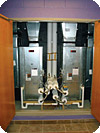
A closed-loop water-source heat pump system was chosen for Petway Elementary to make maintenance and repair work less time-consuming. A closet between every two classrooms houses two heat pumps. The indoor closet placement will help make life easier for service and maintenance.
Both these criteria were met at Vineland Public Schools’ Pauline J. Petway Elementary School, which opened last September. According to Paul Napoli, education market leader for Trane New York/New Jersey, this was the first new school built in the district in 27 years.
A lot of thought and planning went into the project. “The initial design started in 2003,” said Napoli. “The district was always interested in this as a state-of-the-art project.”
The 75,000-square-foot school includes 27 classrooms to serve 580 students in grades K-5; a media center; gymnasium/theater room; cafeteria; computer lab; health suite; conference rooms; and guidance offices.
The project team included the architectural firm of Manders-Merighi Associates, Concord Engineering Group, Schiavone Construction as general contractor, Kisby Shore Corp. as mechanical contractor, and several professionals from Vineland Public Schools.
PRIORITIES AFFECTING HVAC
The first priority for this building, Napoli said, was to control utility costs. Reducing maintenance demands and operating costs was a very close second.In addition, “Classroom acoustics was also a primary objective,” he said. The student body includes a large Spanish-speaking community, and children learning English as a second language need a quiet environment in order to learn most effectively. Indeed, all children learn better in quieter classrooms.
From the start, the project team determined that the school should include mechanical equipment closets, a geothermal heating and cooling system, and improved acoustics, said Wayne Weaver, executive director of physical facilities for Vineland Public Schools. “We had to do a lot of balancing to get the cost per foot to fit into the budget, but in the end the results were highly gratifying.”
The closed-loop water-source heat pump system was chosen to make both maintenance and reactive repairs less time-consuming and therefore, less expensive, Napoli said. The system included commissioned DDC and building management systems, also from Trane.
EQUIPMENT PLACEMENT
The final design included Trane geothermal heat pumps installed in hallway equipment closets. “It doesn’t disrupt school operation or force maintenance to go into after-hours work,” he said. Removing the mechanical equipment from the classroom also helps keep the classroom quieter.“Without the well drilling, the mechanical/boiler room would have been four times the size of what we actually wound up with,” said Paul Farinaccio, CEFM and maintenance superintendent for Vineland Public Schools. “This helped offset the additional square footage that was needed for the closet space and kept the grossing factor from getting completely out of line.”
The indoor closet placement will help make life easier for service and maintenance, Napoli said. “If a leak ever happens, for instance, it would be contained in the closet.” Staff can change filters and check equipment without classroom disruptions.
“There is a closet between every two rooms that houses two heat pumps,” he said. “When the administrators looked at energy costs and lifecycle analyses, they saw that they would save by including mechanical equipment space in the main building.”
The heat pumps fit nicely between every classroom. Short duct runs add to savings due to fan pressure and electrical energy consumption.
POSITIVE RESULTS
A third-party consultant tested classroom acoustic levels against Leadership in Energy and Environmental Design (LEED) for Schools. A proposed change to the LEED’s sound levels would bring it to 45 dBa; Petway Elementary’s levels were measured at 43 dBa with the heat pumps running, Napoli said. “They lined the ductwork as well as the equipment closets.”“I don’t think they are going through the process of registering for LEED,” he continued. “However, the building was designed in accordance with LEED standards. All across the state, schools are being designed with LEED criteria in mind. However, those same school districts seldom are taking it all the way through the actual registration process.”
When speaking at the Schools for the 21st Century national conference in New Orleans earlier this year, “I referenced Petway Elementary School in more than half of the real world examples I cited,” particularly those regarding acoustics, operations-maintenance, and reducing energy consumption.
“This project is proof that innovation can be practical; just think about the serviceability factor that is provided by removing equipment from the classroom,” he said.
“This project had three things in common with every other successful school project that I have been involved with,” Napoli told school administrators at that event. “First, goals were clearly articulated during the initial design meetings. Second, a very passionate administrator was willing to fight every step along the way to make sure those goals were being designed into the project.
“And third, the design team used lifecycle modeling software to analyze all of the key systems and technologies from a holistic approach, rather than looking at each separate disparate technology as an independent part of the buildings infrastructure.”
The district’s maintenance staff is receiving training “to make sure they can carry it forward,” Napoli said.
“We’ve been with them for the last year. You can design an efficient building (envelop and orientation, high-performance equipment and lighting) and commission the building to make sure it is operating as it was intended. Meanwhile, the third and final aspect is proper maintenance. It’s like a three-legged stool,” he said; “if you get the first two and you don’t get the proper maintenance, it’s going to fall over.”
This design should be considered for all new public schools built in the state, Napoli said.
Publication Date:08/06/2007

Report Abusive Comment